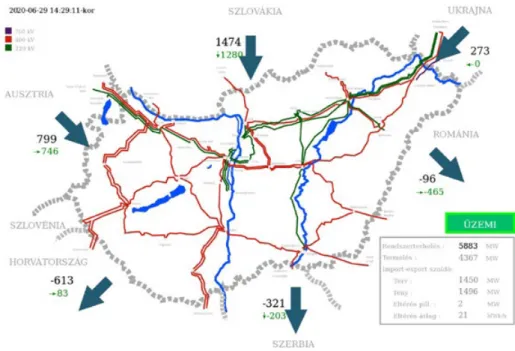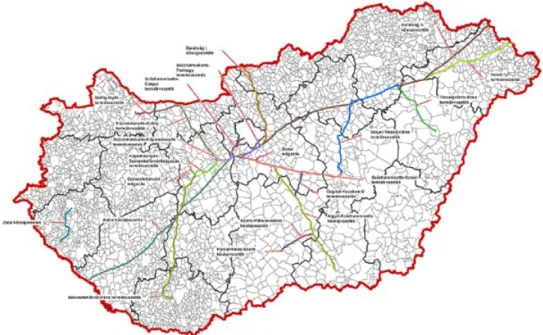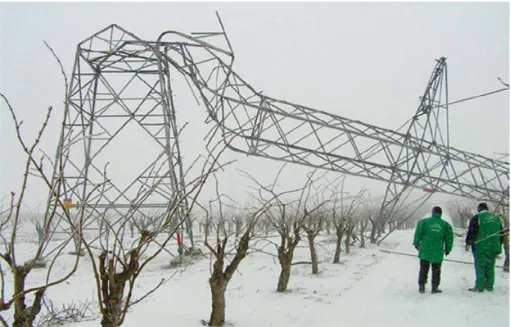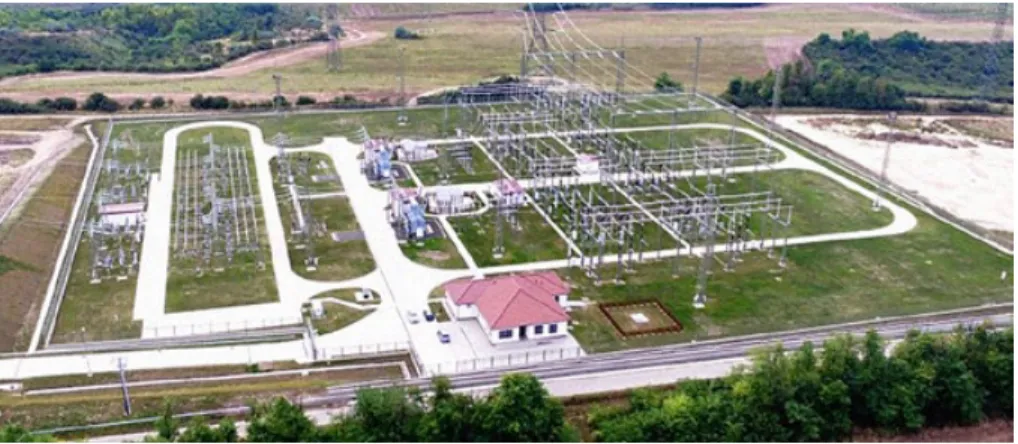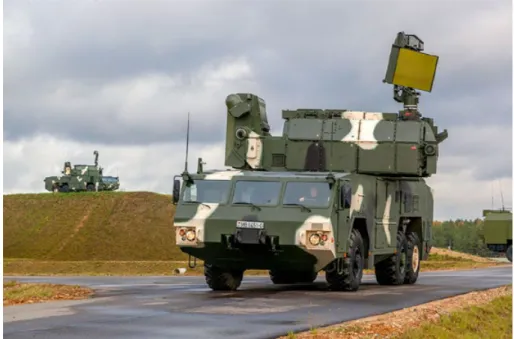DOI: 10.38146/BSZ.SPEC.2020.1.5
Ferenc Molnár
Protection of Critical Infrastructures for Energy Supply
Abstract
Continuous economic and social development is a defining feature of human history. Technological revolutions have been following each other at an ev- er-accelerating pace since the Industrial Revolution. As a result of this devel- opment, our ever-expanding supply of equipment results in a strong increase in energy demand. The comfort of mankind is provided by the ever-widespread electrification, that is, we are encountering electricity-based technologies in more and more areas of our daily lives. In addition to providing convenience, automation and the advancement of digital technologies improve the efficien- cy of economic activities and promote sustainable energy production. The life of an urbanized man is moving towards full automation. Smart homes, in- ternet-based work and commerce are gaining ground. Self-learning software, thinking computers are spreading. Self-propelled vehicles run a test run. With- out the continuous, reliable availability of electricity today's advanced technol- ogies are worthless. Without electricity life stops. Based on this recognition, energy systems’ infrastructures are increasingly exposed to external attack. In addition to the reliability of technologies that play a decisive role in the sup- ply of energy, it is necessary to take effective action against potential threats from the environment. This article, along with a description of power supply systems, identifies potential external threats and remedies available.
Keywords: energy, sustainable development, energy supply, security, infra- structure
Preamble
Our everyday life today is unthinkable without electricity. We cannot mention a segment of households, industrial and agricultural production, medicine, R&D,
education and countless areas where electricity demand would not be present in any form. The continuous availability of electricity is also one of the corner- stones of our daily security. Public administration, property protection, law and order and national defense cannot be deprived of the power supply of systems under continuous electrification development. Our comfort and security are in- creasingly energy-dependent, making us vulnerable to energy supply systems.
Structure and operation of the Hungarian electricity system
Electricity is generated in power plants through various specific conversion technologies from a variety of primary energy sources. Primary energy sourc- es can be nuclear, conventional fossil (coal, lignite, natural gas, oil), renewable (waste, biomass, biogas, solar, wind, water, geothermal).
The power plants are intended to be basic, scheduling and peak power plants.
• System power plants ensure systematic production over time at continuous system operation. This is also called cord production or base load. These are nuclear power plants and coal-fired power plants.
• Scheduling power plants meet predictable power demands with well-cont- rolled load capacities. These include 3 + generation nuclear power plants (Paks 2 technology), combined cycle gas turbines, natural gas fired power plants, controllable renewable base power plants (biomass, biogas, geot- hermal, hydro reservoir).
• Peak power plants can be loaded with open-cycle quick-start gas turbines, rota- ry shaft, no-load turbine generator units, and energy storage units in the event of unpredictable rapid, significant load changes or sudden energy demand.
The electricity produced is passed on to the consumers, i.e. the users, through an electricity distribution network (Figure 1).
The task of the electric network is divided into four hierarchical levels. The core network collects electricity from 400kV and 220kV power from hundreds of megawatts of high-performance power plants and transmits it to node trans- former stations to the 132kV main distribution network. Hungary connects to ENTSO-E through the core European electricity network. The main distribu- tion network, transformed from the 132 kV voltage level, also transmits power through transformer stations to the 35, 20, 10 kV medium voltage distribution network. Large industrial consumers buy from a 132kV or medium voltage net- work. Tens of MW power plants are connected to the main distribution and distri- bution network. After further transformation, electricity will arrive on the 0.4kV
Figure 1: Map of Hungary's basic network Source: (URL1)
Figure 2: Structure of electricity distribution. Source: (URL2)
low-voltage grid, which will supply nearly 3.8 million households in Hungary.
This is more than 99% of the population. (Bonnyai, 2014) By way of illustra- tion, the Paks Nuclear Power Plant with 2000MW power supplies 400kV, the 20MW Felsőzsolca photovoltaic power plant with 20kV, and the 5-50kW house- hold solar power plants with 0.4kV power to the electricity grid. Operational management of the network is carried out by system operators. Downstream, the core network is controlled by MAVIR (Hungarian Electricity Transmission System Operator), owned by MVM Zrt., the distribution network is controlled by the KDSZ (District Dispatcher Service) and the UICs (Operational Control Centers) belonging to the electricity suppliers (Figure 2).
The natural gas supply system
More than 60% of Hungary's energy consumption comes from imports of fossil primary energy sources. Almost 90% of natural gas imports come from Russia via the Brotherhood gas pipeline. The remainder reaches the country via the Győr-Baumgarten line. Domestic distribution is provided by 400 gas transmission stations and a total gas pipeline network of 5780 km with a pressure of 63 bar.
Figure 3: High-pressure pipeline network of Natural Gas Supply Ltd. Source: (URL3)
The country has more than 4 billion m3 of storage capacity for strategic natural gas storage with 55 million m3 of daily storage capacity.
The oil supply system
Domestic oil production is able to cover only a fraction of domestic consumer demand. Most of the imports come from Russia under Friendship II. crude oil pipeline. It has a capacity of 10 million tons per year. It serves as a safety re- serve for the Friendship I line from Slovakia with a capacity of 5 million tonnes per year. The third supply option is the Adria transport pipeline, with an annual transport capacity of 10 million tonnes (Bonnyai, 2014).
Possible external hazards of power supply systems Critical infrastructures
Economic and social development is accompanied by modernization and wide- spread adoption of technologies. As a result, a network of technologies and ac- tivities for various purposes, linked to each other at many points, has been and
Figure 4: The pipeline network of the Hungarian Oil Company (MOL Plc.). Source: (URL4)
is still evolved. Infrastructures have been created. There are several sources of alternatives to the definition of infrastructure, even if interpreted uniformly. In summary, we can speak of economic and technical condition systems that are not direct components of the production process, but are networks, facilities, utilities, bases, processes, activities without which the desired goal could not be achieved. Organizations and facility systems that serve life and well-being of citizens are vital to the functioning of society. Critical infrastructures are fa- cilities whose destruction or limited availability has a negative impact on the existence and quality of life of the affected users.
Act CXXVIII of 2011 on Disaster Management and Amendments to Relat- ed Laws on the implementation of Act No. 234/2011. (XI. 10.), Section 1, par- agraph 25 reads as follows. Critical Infrastructure: Devices, systems or parts thereof located in Hungary that are essential for the fulfillment of vital social functions, health, safety, human economic and social wellbeing, and the disrup- tion or destruction of which would result in a lack of continuous performance.
This concept is completed by the following 5 basic features:
• interdependence - correlation;
• IT Security - Highlights, Digitized Workflows;
• operation - peculiarities, unique character;
• domino principle - chain reaction type injury / damage;
• weakest link and part-whole principle - the stability of interconnected net- works depends on the strength of the weakest element.
Based on present experiences and results of foresighted planning activities, it can be concluded that, in addition to the risks posed by deliberate harmful ac- tivities of human origin, situations should also be prepared for (URL5).
Critical systems and facilities
In the context of the protection of European critical systems and facilities, the Minister for the Interior shall perform national contact and coordination tasks.
Governmental co-ordination of disaster management, civilian crisis manage- ment and critical infrastructure protection tasks, as well as the preparation of legislation on tasks related to these elements, also fall within the competence of the Minister of the Interior. The Energy Government Decree deals with the energy sector in three sub-sectors. These are the installations of the electricity system, the oil industry and the natural gas industry (Sibalin, 2017).
European and National Criteria for the Electricity Sub- sector (360/2013. (X. 11.) Government Decree):
Criteria for designation of constituents at European level:
• The loss of a system component alone leads to a limitation of the service for at least 6 hours, resulting in a permanent power or import capacity shortfall of up to 7% of gross domestic use plus imports;
National Element Designation Criteria:
Production of electricity:
• Failing which security of supply cannot be maintained and cannot be repla- ced within 30 minutes. The loss of a system component that cannot be rep- laced by imports or otherwise shall result, for at least 24 hours, in a loss of power of at least 10% of the average gross peak consumption of the three years preceding the test for all domestic electricity production.
Transmission network:
• A system component whose failure causes any other component to devia- te from the voltage level specified in Annex 2 of the Regulation for more than 24 hours and cannot be replaced in any other way for the performan- ce of the activity.
The distribution network:
A system component larger than 1 kV but not more than 132 kV for which:
a) downtime of at least 10,000 users in excess of 24 hours but less than 48 hours, b) at least 5000 users with an outage of at least 48 hours but less than 72 hours; or c) an outage of at least 72 hours will exclude at least 2000 users from receiving.
European and sectoral designation criteria for the oil system:
(360/2013. (X. 11.) Government Decree):
European constituent designation criterion
In the case of the petroleum industry, no component loss of more than 90 days for crude oil supply, petroleum refining and strategic stockpiles may be made up.
National Element Designation Criteria:
A component whose irreparable shortage causes the domestic demand for fin- ished products (motor gas oil, gasoline, kerosene jet fuel) to be at least 70%
beyond 55 days.
European and sectoral designation criteria for the natural gas system (360/2013. (X. 11.) Government Decree)
European constituent designation criterion:
• In the case of the natural gas industry, the interruption of the component within the time limit specified below for the provision of the relevant ac- tivity shall not be made otherwise. 1 day of system operation, natural gas transmission, natural gas distribution. 10 days of commercial storage. 40 days of strategic storage. 50 days of natural gas import. 90 days of natural gas processing and other natural gas plants.
National Element Designation Criteria:
Natural gas transmission and system management
• A system component which, in the event of disruption, is up to 85% of its capacity required to secure the supply of domestic natural gas in line with average consumption conditions, and cannot be replaced in any other way for the provision of the activity concerned.
Production of natural gas:
• A component with up to 40% of the availability of committed production capacity in the event of a break of at least 72 hours and which cannot be replaced in any other way for the performance of the activity.
Natural gas Storage:
• A component with up to 40% of the availability of committed withdrawal capacity in the event of a break of at least 72 hours and which cannot be replaced in any other way for the performance of the activity.
Natural gas distribution (gas receiving station, high pressure or medium pres- sure natural gas distribution pipeline):
• The component whose
a) downtime of at least 10,000 users in excess of 24 hours but less than 48 hours,
b) at least 5000 users with an outage of at least 48 hours but less than 72 hours; or
c) a downtime of at least 72 hours excludes at least 2000 users from the pos- sibility of receiving natural gas.
Expected sources of danger from the natural environment
Environmental hazards are primarily weather or geological disasters that have a significant negative impact on the living conditions and the well-being of the people concerned. A common feature of natural hazards is that the time, place, extent and process of their occurrence are unpredictable or very difficult to pre- dict. Therefore, defending them should also be a major focus of disaster pre- vention. In the following, I would like to list these whimsical environmental effects together with possible means of controlling them.
Inland water, flood, lightning
Hungary is located in the deep part of the Carpathian Basin surrounded by the Carpathians, the Alps and the Dinaric Mountains. Almost three-quarters of the country's territory is below 200m above sea level. The waters collected from the surrounding mountains flow through the country, leaving the country south.
There is a high risk of dangerous levels of floods and inland waters. 95% of the volume of flood water comes from abroad. A total of 22 rivers are responsible for the drainage of water, with a total length of 2,800 km (Gyenes, 2017). In the unfavorable case, the power supply technology system elements may be sub- merged. This will result in power failure and equipment damage. The most ef- fective means of protection is to prevent disasters, i.e. to prepare for the potential damage caused by floods and inland water. The tools of defense are as follows:
• Continuous improvement of forecasting systems and methods.
• Design and construction of dams and drainage facilities as physical protection.
As part of this, the construction of channels, sumps, pump shafts, dredgers.
• Careful design of superstructure of power supply systems, including proper leveling and sufficient stability of building foundations.
• Construction of critical roads with sufficient strength and stability.
• Establishment of reservoirs and catchment areas taking into account furt- her utilization of the captured water, e.g. energy, irrigation, fish farming, sports, leisure.
• Promoting innovation in the use of flood wave energy.
Strong, stormy winds, gusts of wind
Strong winds and gusts can be expected anywhere in the country. There can be 90-120 km / h gusts of wind or tornadoes. Wind gusts above 120 km / h can cause
the power line column to fall or be damaged, or cause a wire break. Damp soil increases the likelihood of columns falling out. The risk of pipeline ruptures is also increased by the loading of ice-crushed snow on their surface. Trees fall- ing overhead can also cause power outages.
Proper static dimensioning of power line poles, careful design of roof structures in power supply systems, and regular maintenance of power line guardrails can be an effective means of preventing adverse effects.
Temperature effects
Extreme cold can occur anywhere in Hungary, which can often be below -25 °C or even below -30 °C. This can cause line breaks, breakage of supporting and tension insulators, overload of gas supply systems, malfunctions of coal-fired power plants due to frozen coal supply systems, and failure of SF6 gas-insu- lated electrical equipment. Wind turbine blades can cause increased icing, thus reducing operational efficiency. Extreme heat can occur anywhere in Hungary, which can include temperatures above 40 °C. Increased use of air conditioning systems can cause overloading of power supply systems. In extreme cases, due to the reduction in cooling capacity, the output of some base stations needs to be
Figure 5: Falling post on a 220 kV dual-system transmission line. Source: (URL6)
reduced. Solar power plant production is also negatively affected by high am- bient temperatures. Supply restrictions may occur due to overheating of main equipment such as transformers or compressors. Forest fires also threaten the operational safety of power supply system components. Defensive planning of the equipment from a technical and operational point of view can be a defense option. Application of best available technologies. Design of shades and backup cooling systems. Forest fire detection and fire extinguishing facilities should be prepared especially for the protection of vital facilities and equipment. Flood and inland trapped water resources could be used for sport and agricultural use as well as for additional cooling and firewater systems.
Thunderbolt
There are hundreds of thousands of lightning strikes per hour on Earth. Light- ning strikes can occur anywhere in the country. Their annual frequency is char- acterized by an average of 2 lightning strokes per square kilometer. Lightning strikes a current between 30 and 300 kA. Their damaging effects can be damage to track facilities or failure of outdoor transformers. It may be a direct destruc- tive effect, but it may also be a transient increase in voltage from the secondary effect. Lightning surge can cause electrical equipment to malfunction. Protec- tive measures may include the installation of suitably sized lightning protection systems, the application of surge protection measures, and the design of care- fully designed grounding systems.
Extreme amount of snow
Over a period of 24 hours, more than 30 cm of snowfall can occur in any area of the country. Heavy snow obstructs traffic, making it difficult to carry out oper- ations and troubleshooting. Extremely increased snow loads cause mechanical overloads and damage. Possible defenses include preparation. Provision and availability of snow removal equipment. Strength dimensioning of system com- ponents exposed to mechanical overload with appropriate engineering margin.
Earthquake, landslide
The 2000 earthquake catalog recorded more than 20,000 cases. Hundreds of earthquakes can be detected by instrument every year. The most important task
of earth sciences is to predict vibrations as accurately as possible. The occur- rence and negative impact of earthquakes should be considered. Soaked soil structures and stretches of hillsides carry the risk of landslides. There are more and more examples of these cases in Hungary.
As a defense, careful selection of site locations and thoughtful static sizing can be one solution. Earthquake strengthening of existing facilities should be car- ried out. Continuous inspection and review of facilities should be performed.
Continuous improvement of forecasting methods and improvement of their ac- curacy are prerequisites for effective prevention. International cooperation on learning from experience and development also plays an important role here.
An important part of the defense is the preparation and, if necessary, disciplined and trained implementation of disaster management measures.
Human vulnerability of energy supply infrastructures
The first infrastructures of human societies were road networks and irrigation systems. After the emergence of infrastructures, threats to them have also been
Figure 6: Paks Nuclear Power Plant Earthquake Reinforcement Brace Steel Bridge Structure Between Localization Towers. Source: (URL7)
emerged. In addition to being endangered by the natural environment, damage to human origin is also a threat to welfare and comfort systems. Most of the damages serve to intimidate the population and to undermine the trust in current political power and to insecure people. Along with industrial development, the risks of industrial origin due to technological errors are constantly increasing.
The probability of their occurrence and its negative effects are determined by the application of the best available technologies, by constantly updated regu- lations, by regular inspections of the relevant bodies, etc. They can be reduced by working closely with disaster management. The most important threats from civilization are epidemics, depletion of the Earth's resources, dangerous industrial facilities and cyber attacks. Cyber threats can also be classified as deliberate, harmful activities. Attacks against IT-based technologies have now increased to the level of threat, posed by terrorist attacks, armed conflicts, rev- olutions and riots. The major components of power supply systems are large in scope, such as power line trace installations, pressure booster stations, distribu- tion boards, transformer stations, power plants, control centers, which are vital to the operation of the system. The possible attacks on these large numbers of objects also depict a very diverse picture. Without limitation, unauthorized or mentally injured individuals may include intrusions, theft of property, armed attacks, remote shots, damages caused by protests, sabotage by members of or- ganizations, drone attacks, or drone bombs.
Previously, physical protection was sufficient against attacks. This includes the use of concertina wires, security walls, locks, security cameras, field lighting, motion detectors, door detectors, access control systems, detection gates, alarms,
Figure 7: MAVIR ZRt. Kerepes 400/120 kV substation. Source: (URL8)
infrared barriers and security guards, even nowadays. Physical defense, in its constantly evolving form, is an indispensable defense tool even today. Succes- sive technological revolutions place increasing emphasis on protecting against new IT-based attacks. The place where digital data and information is stored, called cyberspace, where attack and defense take place. The IT tools needed to create cyberspace are also provided with increasingly sophisticated physical protection. In addition to more and more tight regulation, firewall software de- velopers have an increasing task. As a result of increasingly sophisticated at- tacks damages caused by cyber attacks are almost three times more than dam- ages caused by natural disasters. The threats posed by IT-driven drones also mean a greater threat to the operational security of power supply systems day by day. Today, drone defense systems are still in the early stages of develop- ment. The efficiency of currently known, used or experimental systems can be greatly improved and their relatively high cost of ownership is considered de- pending on the level of security of the object to be protected. In practice, the means of protection against drone attacks include: electromagnetic dome shield, radar stations, electromagnetic weapon, sleeping weapon, drone deterrent soft- ware, drone tracking software, interfering frequency of electromagnetic field, trained predator birds.
Figure 8: Complex defense against drones in Russia. Source: (URL9)
Summary
Economic and social development brings with it the rapid development of pro- duction tools, technologies and systems that improve the comfort and quality of life of mankind. Constant technological advances and the ever-increasing standard of living also involve a drastically increase of energy demand from the Earth's population. The share of electricity consumed in total primary energy consumption is constantly increasing thanks to powerful electrification and au- tomation. Without the continued availability of electricity, modern economies and societies would be paralyzed. Nor would primary care systems guarantee the living conditions of the population. The reliability of the technology of en- ergy supply systems must be constantly improved, but in addition to this, the security of energy supply must be protected against possible external threats.
These can be weather and geological hazards, but they can also be human threats.
Energy dependence and vulnerability to power supply systems have also been recognized by hostile and malicious people and groups of people. Physical and cyber-attackers are also leveraging technological innovation to launch more and more damaging attacks on power system infrastructures. As technology continues to evolve, defenses against external threats to power supply systems need to be raised to an ever-increasing level in order to maintain the conditions of society and national security.
References
Bonnyai T. (2014): Analysis of Critical Infrastructure Protection in the Light of Population Preparation. PhD Thesis
Gyenes Zs. (2017): National Disaster Risk Assessment. Ministry of Interior National Disaster Management Directorate. UNISDR, 5.
Sibalin, I. (2017): Energy Significant Systems and Regulation Relating to the Protection of Fa- cilities Presentation. In: National Energy and Climate Plan of Hungary, 15-25.
Legislation used
234/2011. (XI. 10.) Korm. rendelet a katasztrófavédelemről és a hozzá kapcsolódó egyes törvé- nyek módosításáról szóló 2011. évi CXXVIII. törvény végrehajtásáról [Government decree implementing law no CXXVIII / 2011 On disaster management and on changes of certain connecting laws]. https://net.jogtar.hu/jogszabaly?docid=a1100234.kor
Online links in this article
URL1: Magyar Villamosenergia-ipari Átviteli Rendszerirányító ZRt [MAVIR Hungarian Trans- mission System Operator Company Ltd.]. https://www.mavir.hu/web/mavir
URL2: The Electric Power Transmission and Distribution Industry. https://hu.pinterest.com/
pin/458311699548778210
URL3: Földgázszállító [Natural gas supplier]. https://fgsz.hu/
URL4: Magyar Olaj- és Gázipari Nyrt [Member of MOL Group]. https://mol.hu/
URL5: BM Országos Katasztrófavédelmi Főigazgatóság 2019. [National Directorate General for Disaster Management, Ministry of the Interior (NDGDM) 2019.]. http://www.katasztro- favedelem.hu/index2.php?pageid=lrl_index
URL6: Energetikai Szakkollégium [Student Association of Energy]. http://www.eszk.org/
URL7: Iparterv Épülettervező Zrt. [The Industrial Buildings Consulting Co.]. http://iparterv.hu/
URL8: Erőmű Beruházási Vállalat [MVM Erbe Power Engineering & Consulting Ltd.]. http://
www.erbe.hu/
URL9: Atombiztos [Nuclear bomb-proof]. https://atombiztos.blogstar.hu
